Amboina Box Turtle
Cuora amboinensis - Daudin, 1802.
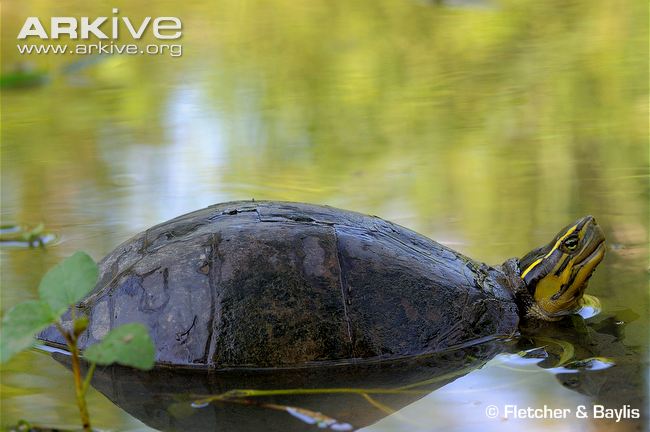 |
| © K. Fletcher & Baylis, from www.arkive.org (permission given) |
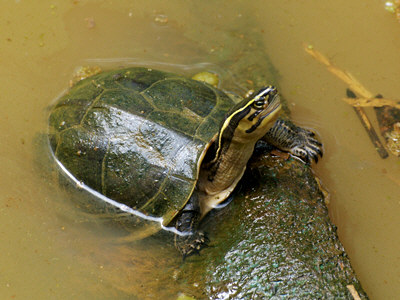 |
| Amboina Box Turtle at Langkawi, Peninsular Malaysia (photo © Nick Baker, Ecology Asia 2013, permission given) |
is more associated with the water than other members of the genus Cuora, preferring to inhabit shallow freshwater systems that are still
or very slow-flowing; however, adult animals are sometimes found having travelled away from any water sources, the reason is unclear. Described as omnivorous, the Amboina box turtle is predatory as a juvenile and then tends towards vegetation as its primary food source when adult; meat is only occasionally consumed by adult animals when it is highly opportunistic (Ernst & Barbour, 1989). Although classified as Vulnerable by the IUCN, this species is hardy and known to thrive under seemingly harsh conditions including within the storm-drains of Brunei and areas afflicted by severe eutrophication. The main threat to this species is the vast numbers that are collected from the wild for use in local cuisine, Chinese medicine and, to a lesser extent, the pet trade.
Description
(Hall, 1995)| Illustration of Cuora amboinensis (©Sowerby et al., 1872) |
There is little obvious sexual dimorphism shown in this species but gender can be determined in the field or lab by examining the tail, males tend to have longer and thicker tails while those of females are short and stubby; the plastron, males will have a more concave shaped plastron to accommodate the female's shell when mating, and, although not as distinguishable, males tend to be smaller than females and have longer claws.
This species is closely associated with water, juveniles are fully aquatic, later tending towards a semi-aquatic lifestyle when mature. While C. amboinensis has webbed feet, it lacks other modifications seen in other aquatic turtle species such as pronounced streamlining of the carapace and the limbs being positioned laterally to aid active swimming. This is due to this species' preference to walk along and sit in shallow pools and streams, it is rarely found in water greater than its own depth. This lack of aquatic speciality allows this species to also move quite rapidly on land and is not out of place when away from water.
There are 4 recognised subspecies of Cuora amboinensis, C. a. amboinensis, C. a. kamaroma, C.a. coura and C. a. lineata. The differences can be seen in the shape of the carapace, with those of some localities being flatter for a more aquatic lifestyle or more domed for the localities with a more terrestrial lifestyle, in the black pigmentation on the plastron and in the colouration of the head. There are also 4 other local populations in Eastern India, Borneo, the Philippines and the Nicobar Islands that may show enough variability to be considered additional subspecies (Filella, 1997).
Table 1. The 4 recognised subspecies of C. amboinensis, giving a descriptive and visual representation of each subspecies' characteristic traits.
| Scientific Name |
Common Name |
Description |
Picture |
|
| Cuora amboinensis amboinensis (Daudin, 1802) |
Amboina Box Turtle |
Flatter, more streamlined carapace. All plastron scutes contain a black marking with a marking appearing in the center occasionally. Yellow head markings are broad. |
from Wikipedia.org, CC |
|
| Cuora amboinensis kamaroma (Rummler & Fritz, 1991) |
Malayan Box Turtle |
Very domed carapace. Plastron is rarely marked. Usually smaller than other subspecies. |
from Wikipedia.org, CC |
|
| Cuora amboinensis coura (Schweigger, 1812) |
Javanese Box Turtle |
Intermediate carapace shape. Black markings on most, but not all, plastron scutes. |
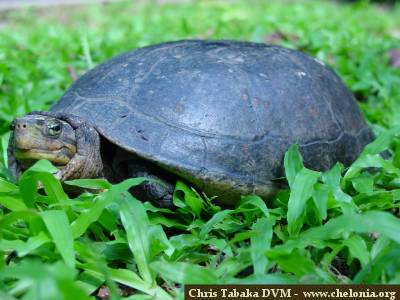 |
© Chris Tabaka, World Chelonian Trust, permission pending |
| Cuora amboinensis lineata (McCord & Philippen, 1998) |
Lineated Box Turtle |
Very domed carapace that contains light markings, usually a stripe running along the length of the keel. All plastron scutes contain a black marking. |
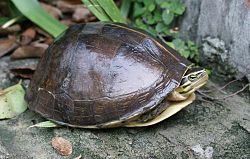 |
from Wikipedia.org, CC |
Distribution
(Schoppe & Das, 2011)Cuora amboinensis is a widely distributed species with numerous countries
 |
| Distribution of Cuora amboinensis. Map from Wikipedia.org (Colouring by Conor Dunne) |
C. a. amboinensis can be located on the east Indonesian islands of Ambon (formally Amboina, from which the common and scientific names originate), Sulawesi, the Moluccas, Buru, Seram, eastern Timor-Leste and many smaller islands within the region.
C. a. kamaroma can be located across south and central Vietnam, southern Laos, Cambodia, Peninsular Malaysia and Myanmar as well as in Singapore. The native Singaporean population consists entirely of this subspecies, any occurrence of another subspecies or variant is most likely due to it being released. The population within Singapore is small and most likely confined to the Central Catchment Nature Reserve (Baker & Lim, 2008; Corlett, 1992). Unfortunately, there is little to no research on the populations of most non-marine Chelonians that are native to Singapore. However, the small population within Singapore is described as stable by the IUCN, so long as the area remains undeveloped (IUCN, 2000).
C. a. cuora can be located on the south Indonesian islands of Sumatra, Java, Bali and Sumbawa, as well as other small islands within the region.
The range of C. a. lineata is, so far, restricted to Myanmar, although it is a newly recognised subspecies (1998) and its range may be extended.
Populations of C. amboinensis are also found in the north-east of India, Bangladesh and possibly Sri Lanka, throughout the Philippines, the entire island of Borneo and upon the Nicobar Islands, north of Sumatra that are thought to represent at least 4 new additional subspecies but until their verification, they are classified within the four existing subspecies (Filella, 1997).
Biology
Habitat
The preferred habitat of Cuora amboinensis is the lowland tropical rainforests that are prevalent throughout its range. It is restricted to areas that maintain a constant temperature range of between 24oC to 35oC and is never found in areas where temperatures fall below 21oC; this species seems to lack the ability to survive in colder temperatures that many other species within the Cuora genus possess. Heavily associated with water, but preferring to avoid actively flowing streams, this species is most likely found in still, shallow pools with a soft substrate that do not exceed the animal's depth, such as those found in marshes, swamps and ponds. Juveniles a fully aquatic and do not leave the water until they reach maturity, at which point the species adopts a semi-aquatic mode of life. Adults alternate between living within the pools and being buried under damp near a water body during the day (Bronin, 2006). This species can often be found in many human-modified habitats such as those in rice paddies and oil palm and rubber plantations; they are also commonly found in irrigation ditches or canals (Schoppe & Das, 2011).
Diet and Feeding
Like the transition from an aquatic lifestyle to a semi-aquatic lifestyle, there is a transition in the preferred diet of Cuora amboinensis between juveniles and adults. While omnivorous for its entire 30 year lifespan, the primary diet during early life consists of meat obtained from arthropods, molluscs and small fish, seemingly preferring soft-bodied prey items such as slugs and annelid worms. Vegetation is still consumed, but only if prey items are scarce. Hunting is highly opportunistic, when a potential prey item is spotted, usually at the waters edge or upon a piece of debris in the water, the animal will slowly approach in the water and grab the prey using a quick extension of its long neck, the prey item is consumed underwater (Natchev et al., 2009) . When C. amboinensis reaches adulthood, a wide variety of vegetation is consumed instead of meat, this includes green leaves, vegetables, fallen fruits, fungi and numerous aquatic plants. Meat is still consumed throughout the animal's life but only when it is highly opportunistic (Schoppe & Das, 2011; Rogner, 1996). Most feeding is still done in the water as C. amboinensis only possess short and broad lingual papillae on the tongue and a flat roof of the mouth, these features indicate an inefficient method of terrestrial food transport and the skull and feeding apparatus are more suited to consume food items underwater (Natchev et al., 2009). C. amboinensis is a nocturnal species and most foraging is conducted at night, during the day the animal retreats to a pool of beneath a pile of damp, fallen leaves.
Aquatic Prey Capture of Cuora amboinensis under laboratory conditions. Photos © 2008 Elsevier GmbH, all rights reserved (permission given).
Reproduction
Cuora amboinensis has an approximate lifespan of 25 to 30 years, reaching sexual maturity at 4 to 5 years old. Fertilisation is internal and copulation occurs in the water, there is little courtship or ritual to the mating process, males will often bite at a females' head to force her to close the protective hinge over her head, this opens up the back of the shell for the males to access. There is no fixed mating season, mating occurs throughout the year with females often laying several clutches each year. Nest are constructed by the females, they consist of a large hole dug into the ground of a well drained area, to avoid flooding of the nest. Clutch size is unusually small with the range of egg numbers per clutch only being between 1 and 5. The average gestation period (in captivity) is 76 days from fertilisation to hatching. Eggs are large (14g - 31g) and spherical in shape, they show a wide variety in size and incubation time due to this species wide range and various subspecies. There is no parental care shown by either parent once mating has been completed by the male and once the eggs have been buried by the female. Hatchlings have a straight carapace length of only 5cm, they have a very low survival rate and are important prey items for monitor lizards, herons and small mammals (Moll & Moll, 2004;Barbour & Ernst, 1992).
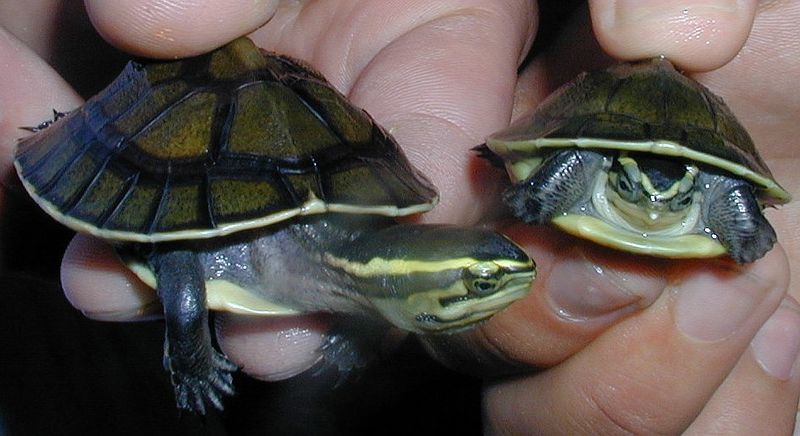 |
| Juvenile C. a. kamaroma (from Wikipedia.og, CC) |
Conservation
C. amboinensis is currently listed as Vulnerable and has been since the year 2000 (Hilton-Taylor, 2000), having been previously assessed as Lower Risk in 1996 (Baillie & Groombridge, 1996). A victim of the ongoing deforestation throughout its home range, the Amboina box turtle is also heavily exploited by humans for food, traditional Chinese medicine and the pet trade. This species can be very difficult to breed on a large scale in captivity and therefore the vast majority of animals used in human activities are collected from the wild. In 2004, the Malaysian CITES Management Authority urged traders to establish commercial breeding operations to quell the wild-caught supply. However this venture was economically infeasible and abandoned (PERHILTON, 1992). In Peninsular Malaysia, the Amboina box turtle is commonly found in market stalls for a variety of purposes (Lim & Das, 1999).
The Amboina box turtle is believed to have many uses within traditional Chinese medicine; the heads and shells are used to make a tonic for after childbirth, the flesh is believed to help stop bed-wetting in children and the flesh and plastron are consumed as cures for asthma and cancer. The turtles are often bought for "merit release", this is when an individual will release the turtle back into the wild in order to bring good karma or luck to themselves; while this may not seem as serious a problem, the purchase of the turtles for release drives the demand and more animals most be collected (Lim & Das, 1999). The vast majority of the turtles extracted from their geographic range are exported to other parts of Asia, the main destinations being China, Hong Kong, Taipei and Singapore. Before the species was listed into Appendix II of CITES, export was unregulated and often undocumented, although some reports show that 456, 541 were exported from Peninsular Malaysia between January and October 1999 alone (Sharma & Tisen, 2000). A statement taken from an exporter in Malaysia in 1999 claims he had been buying over 800 Amboin box turtles daily for export to China. The species was listed in Appendix II of CITES in 2000 which put export quotas on the trade of C. amboinensis; however 330, 099 individuals are known to have been illegally exported into other parts of Asia on top of the quota, this number cannot be exact and its likely that many more were exported unnoticed. As well as the exportation of this species throughout Asia for food and traditional medicines, 12,785 individuals, known to CITES, were exported from Malaysia to Europe and North America for use in the pet trade. These figures only adhere to the numbers exported from Peninsular Malaysia, there is no available documentation on the exportation from other countries within this species' range and the actual figures are therefore much greater (Schoppe, S., in press).
International trade of Cuora amboinensis was banned in the year 2006 and since then there have been no reports on the numbers exported. The amount of illegal activity can only be estimated from customs seizers by the importing countries, There is still a huge demand for these turtles and illegal trade is rampant across three trade routes from Malaysia, by land through Thailand and by air from Kuala Lumpur to reach China as well as by air from Johor Bahru to reach the markets of Singapore. Trade regulations and decreasing population sizes have resulted in a large price increase of Cuora amboinensis plastrons in Chinese pharmacies with the average price being 45.60USD in 2006, up from only 10.9USD just 4 to 6 years previously. The price increase has led to the establishment of moderate commercial farms operating at an out put of 1,000 to 10,000 hatchlings a year, although illegal importation is still the main source of Cuora amboinensis.
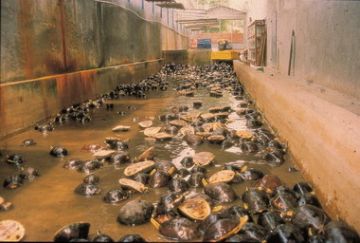 |
| Wild-caught C. amboinensis in a holding pond in Sumatra © Shepard, C.R., TRAFFIC (permission pending) |
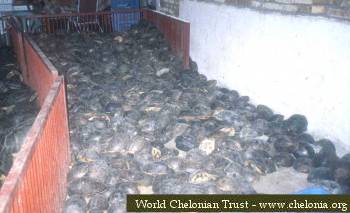 |
| C. amboinensis after being imported to China © McCord, B., World Chelonian Trust (permission given) |
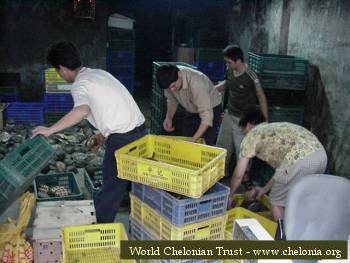 |
| Sorting of the turtles for distribution © McCord, B., World Chelonian Trust (permission given) |
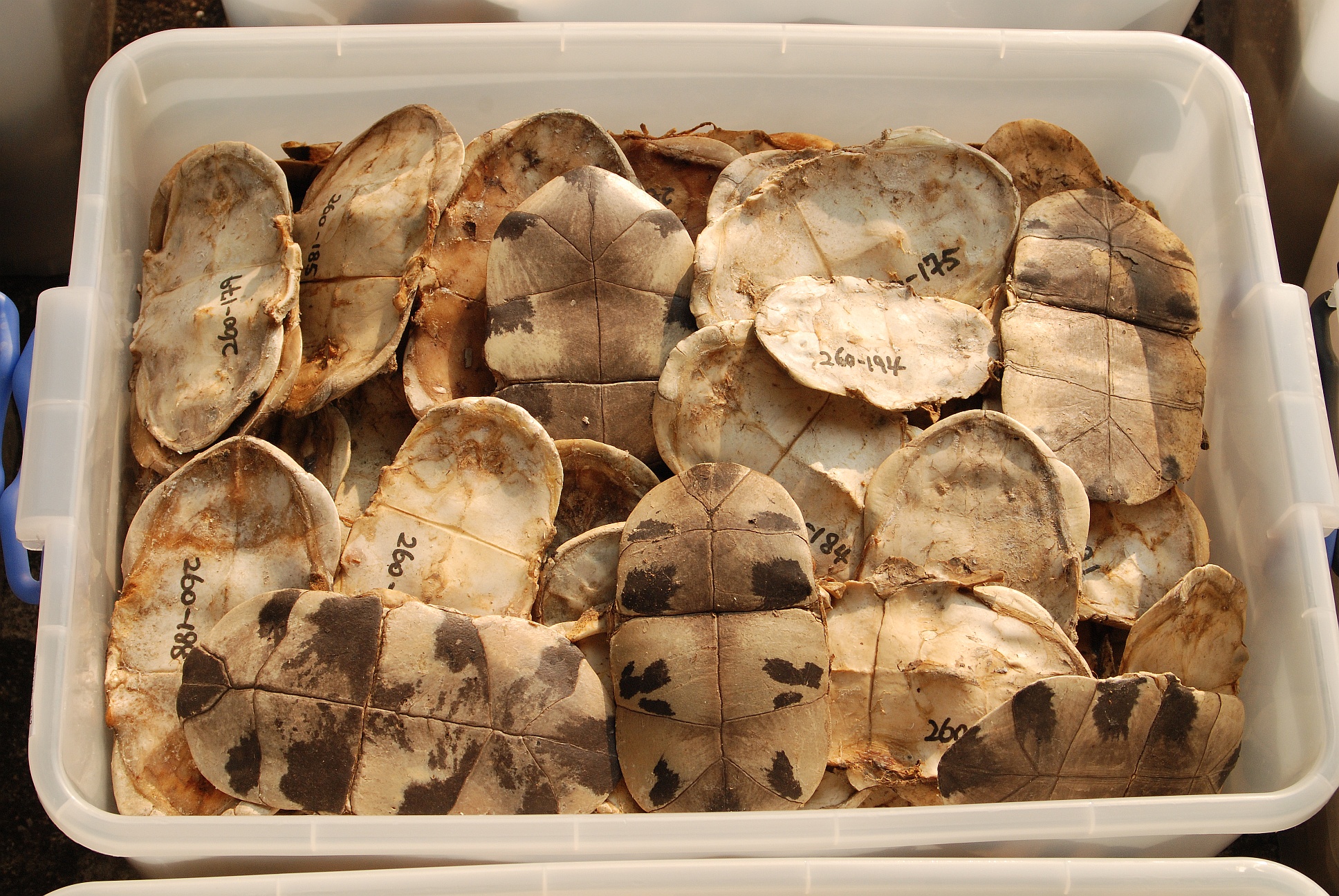 |
| Plastrons of C. amboinensis used in traditional Chinese medicine © Kendrick, R.C., 2006. IUCN/SSC (permission given). |
Nomenclature
Scientific Name
Cuora amboinensis
(according to the Integrated Taxonomic Information System, Taxonomic Serial Number: 551907)
| Synonyms |
Vernacular Names |
|
|
Etymology
This species derives the common name "Amboina" and the latter part of its scientific name "amboinensis" from the island of Amboina which has since been re-named Ambon Island, part of the Moluccas island group in Indonesia. This is where the holotype of the species was described by Daudin in 1802.
Taxonomy
Classification
Kingdom: Animalia
Phylum: Chordata
Class: Reptilia
Order: Testudines
Suborder: Cryptodira
Family: Geoemydidae
Genus: Cuora
Species: Cuora amboinensis - Daudin, 1802
- Subspecies: Cuora amboinensis amboinensis - Daudin, 1802.
- Subspecies: Cuora amboinensis kamaroma - Rummler & Fritz, 1991.
- Subspecies: Cuora amboinensis cuora - Schweigger, 1812.
- Subspecies: Cuora amboinensis lineata - McCord & Philippen, 1998.
Cuora amboinensis belongs to the family Geoemydidae (Theobald, 1868), the largest and most diverse family within the order Testudines. This family consists of 23 genera representing 73 species that are widely distributed across Europe, Northern Africa, Southern Russia, India and throughout Southeast Asia; most are freshwater aquatic or semi-aquatic, giving rise to the vernacular name "Old World pond turtles" (Iverson, 1992; Spinks et al., 2004; Ernst & Barbour, 1989). The once monophyletic genus of Rhinoclemmys was considered the only genus of this family to be found in the New World, in Mexico, south into Venezuela, Ecuador and Brazil; this genus has been split into two genera, Rhinochemmys (8 species) and Chelopus (2 species) (Hirayama, 1984; Yasukawa et al., 2001).
C. amboinensis currently resides in the genus Cuora, a group commonly referred to as the Asian Box Turtles. The number of species within this genus is variable as there is much debate on the taxonomic relationships between the species, the splitting of one species in two or more as a result of genomic bar-coding and the elevation of subspecies to species level. Cuora was previously split into two genera, Cuora and Cistoclemmys, giving the former 7 species and the latter 2 (Yasukawa et al., 2001). This has since been revised and the genera Cistoclemmys and Pyxidae have been disbanded and their species placed within the Cuora genus which currently contains 13 species; C. amboinensis, C. aurcapitata, C. pani, C. trifasciata, C. zhoui, C. flavomarginata, C. yunnanensis, C. mccordi, C. bouretti, C. mouhotii, C. galbinifrons, C. picturata and C. cyclomata (Spinks et al., 2012).
Type Specimen
This species was originally described by Fraçois Marie Daudin in 1802 in
Histoire naturelle, générale et particuliére des reptiles; ouvrage faisant suit á l’histoire naturelle générale et particuliére, composée par Leclerc de Buffon; et rédigee par C.S. Sonnini, membre de plusieurs sociétés savants. Volume 2.
The Holotype of Cuoro amboinensis, collected by Daudin, is believed to have been lost at sea.
Neotype MNHN 1941:149, deposited at the Muséum National d'Histoire Naturelle, Paris, France.
Cuora amboinensis kamaroma, Holotype ZMH R00227, deposited at the Zoologisches Museum Hamburg.
Phylogeny
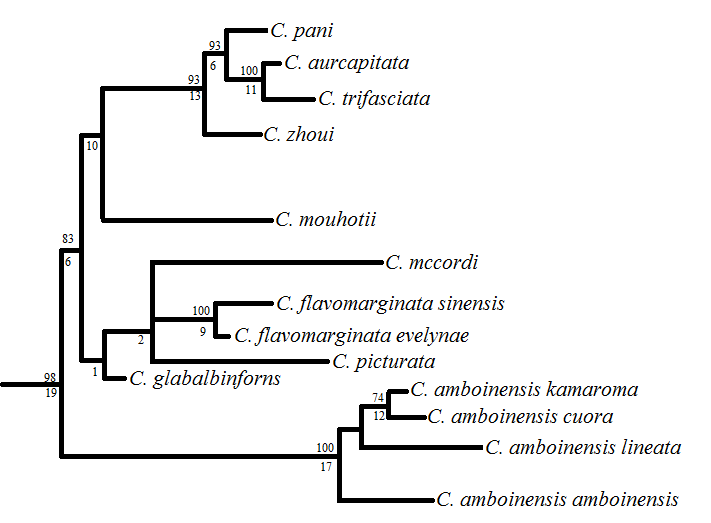 |
| Maximum-parsimony tree based on cytb mtDNA sequences showing the relationships within the genus Cuora. C. cyclomata, C. bouretti and C. yunnanensis are excluded. © 2004 Elsevier Inc. Spinks et al., 2004 (permission given). |
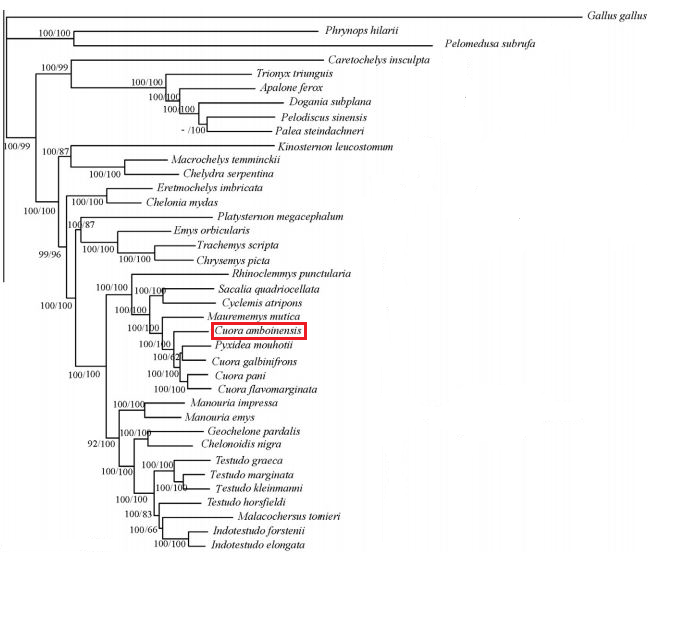 |
| Phylogram generated from ML analysis of the combined dataset using the GTR + G+I model of molecular evolution. Right side numbers are bootstrap values (50%) from 100 replicates of the ML analysis. © 2011 Elsevier Inc. Lourenço et al., 2012, permission pending. |
References
Asian Turtle Trade Working Group, 2000. Cuora amboinensis. In: IUCN Red List of Threatened Species .
Baker, N., Lim, K.K.P., 2008. Wild Animals of Singapore: A Photographic Guide to Mammals, Reptiles, Amphibians and Freshwater Fishes. Draco Publishing.
Barbour, R.W., Ernst, C.H., 1992. Turtles of the World. Smithsonian Institution Press, Washington D.C., pp. 280.
Baillie, J., Groombridge, B., 1996. 1996 IUCN Red List of Threatened Species. IUCN, Gland, Switzerland.
Bell, T. 1825. A monograph of the tortoises having a movable sternum, with remarks on their arrangements and affinities. Zoological journal of London, 2, 299 - 310.
Bonin, F., 2006. Turtles of the World. A & C Black, London.
Corlett, R.T., 1992. The ecological transformation of Singapore, 1819-1990. Journal of Biogeography, 19, 411 - 420.
Daudin, 1802. Histoire naturelle, générale et particuliére des reptiles; ouvrage faisant suit á l’histoire naturelle générale et particuliére, composée par Leclerc de Buffon; et rédigee par C.S. Sonnini, membre de plusieurs sociétés savants. Volume 2. F. Dafart, Paris, pp. 432.
Ernst, C.H., Barbour, R.W., 1989. Turtles of the World. Smithsonian Institution Press, Washington D.C.
Ernst, C.H., Laemmerzahl, A.F., Lovich, J.E., 2011. Does the "kamaroma" - plastron pattern morph occur in both Philippine subspecies of Cuora amboinensis? Proceedings of the Biological Society of Washington D.C., 124 IV, 259 - 269.
Filella, E., 1997. Cuora amboinensis, la Tortuga caja del sudeste asiático y sus subspecies (Cuora amboinensis,the southeast Asian box turtle and its subspecies. Reptilia, 13, 43 – 47 (article in Spanish).
Hall, g. 1995. Asian box turtles. Reptile and Amphibian Magazine, May/June, 110 - 116.
Hilton-Taylor, C., 2000. 2000 IUCN Red List of Threatened Species. IUCN, Gland, Switzerland and Cambridge, UK.
Hirayama, R., 1984. Cladistic analysis of batagurine turtles (Bataguridae: Emydinae: Testudinoidae), a preliminary result. Studia Gelogica Salmanticensia, vol Especial1. Studia Palaeocheloniol, 1, 141 - 157.
Iverson, J.B., 1992. A Revised Checklist with Distribution Maps of the Turtles of the World. Privately Printed, Richmond, Indiana.
Lim, K.K.P, Lim, F.K L., 1992. Guide to the Amphibians & Reptiles of Singapore. Singapore Science Centre.
Lim, B.L., Idraneil, D., 1999. Turtles of Borneo and Peninsular Malaysia. Sabah, Malaysia: Natural History Publications (Borneo) Sdn. Bhd.
Lim, B.L., Das, I., 1999. Turtles of Borneo and Peninsular Malaysia. Natural History Publications, Borneo, pp. 151.
Lourenço, M.J., Claude, J., Galtier, N., Chiari, Y., 2012. Dating crytodiran nodes: Origin and diversification of the turtle superfamily Testudinoidae. Molecular Phylogenetics and Evolution, 62, 496 - 507.
McCord, W.P., Philippen, H.D., 1998. A new subspecies of box turtle, Cuora amboinensis lineata, from Northern Myanmar, with remarks on the distribution and geographic variation of the species. Reptile Hobbyist, 3, 51 – 58.
Moll, D., Moll, E.O., 2004. The Ecology, Exploitation and Conservation of River Turtles. Oxford University Press, pp. 393.
Natchev, N., Heiss, E., Lemell, P., Stratev, D., Weisgram, J., 2009. Analysis of prey capture and food transport kinematics in two Asian box turtles, Cuora amboinensis and Cuora flavomarginata (Chelonia: Geoemydidae), with emphasis on terrestrial feeding patterns. Zoology, 112, 113 – 127.
PERHILTON, 1992. Wildlife Plan for Peninsular Malaysia. Department of Wildlife and National Parks, Kuala Lumpur, Malaysia, pp. 66.
Rogner, M., 1996. Schildkröten, Vol, 1 & 2. Heiro-Verlag, Hürtgenwald, Germany, pp. 49.
Rummler, H.J., Fritz, U., 1991. Geographische variabilitat der Amboina-Scharnierschildkröte Cuora amboinensis (Daudin, 1802), mit Beschreibung einer neuen Unterart, C. amboinensis kamaroma subspecies nov. Salamandra, 27, 17 – 45.
Schoppe, S., in press. Science in CITES: The biology and ecolgy of the Southeast Asian Box Turtle Cuora amboinensis and its local uses and trade in Malaysia. A TRAFFIC Southeast Asia report
Schoppe, S., Das, I., 2011. Cuora amboinensis (Rich in Daudin 1801) - Southeast Asian Box Turtle. In: Rhodin, A.G.J., Pritchart, P.C.H., van Dijk, P.P., Saumure, R.A., Buhlmann, K.A., Iverson, J.B., Mittermeier, R.A. (Eds.). Conservation Biology of Freshwater Turtles and Tortoises: A Compilation Project of the IUCN/ SSC Tortoise and Freshwater Turtle Specialist Group. Chelonian Research Monograph, 5, pp. 053.1 - 053.13.
Schweigger, A.F., 1812. Prodromus Monographia Cheloniorum auctore Schweigger. Königsberg. Arch. Naturwiss. Mathem., 1: 271 – 368, 406 – 458.
Sharma, D.S.K., Tisen, O.B., 2000. Freshwater turtle and tortoise utilisation and conservation status in Malaysia. In: van Dijk, P.P., Stuart, B.L., Rhodin, A.G.J., The status of turtles in Asia: Proceedings of a workshop on conservation and trade in turtles and tortoises in Asia. Chelonian Research Monograph, 2, 15 - 18.
Spinks, P.Q., Shaffer, H.B., Iverson, J.B., McCord, W.P., 2004. Phylogenetic hypotheses for the turtle family Geoemydidae. Molecular Phylogenetics and Evolution, 32, 164 - 182.
Spinks, P.Q., Thomson, R.C., Zhang, Y., Che, J., Wu, Y., Shaffer, H.B., 2012. Species boundaries and phylogenetic relationships in the critically endangered box turtle genus Cuora. Molecular Phylogenetics and Evolution, 63, 656 - 667.
Sowerby, J.C., Gray, J.E., Lear, E., 1872. Tortoises, Terrapins and Turtles: drawn from life. J. Bear & co., London, Paris and Frankfurt.
Yasukawa, Y., Hirayama, R., Hikida, T., 2001. Phylogenetic relationships of Geoemydine turtles (Reptilia: Bataguridae). Current Herpetology, 20, 105 - 133.